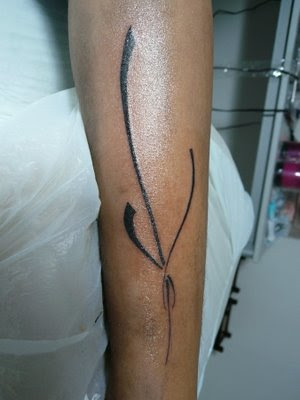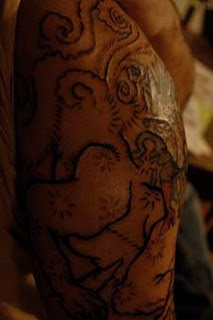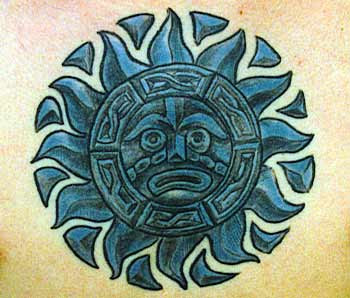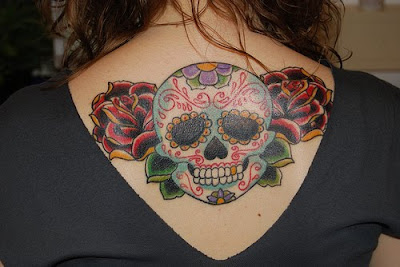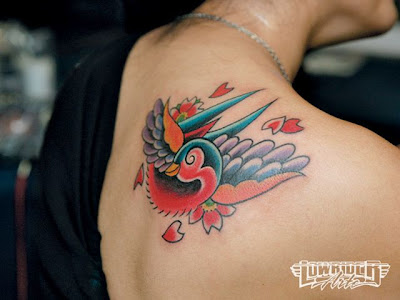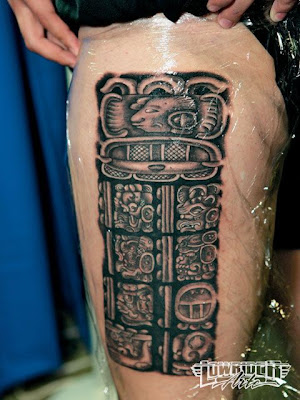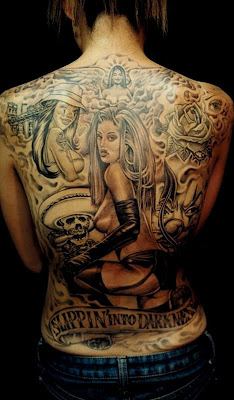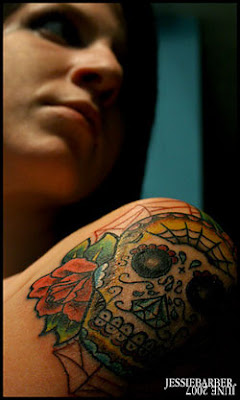The
History of Mexican Tattoo
aztec calendar
Contrary to common belief, Mexican tattoos began long before the stereotypical ideas about them – the idea that Mexicans have only been tattooing for a hundred years or so is a misconception. Tattoos in the Mexican
culture date back to the early 1300s and perhaps before that. Both the Aztecs and the Mexica, along with other Mexican
native tribes used tattoos as
ornamental and as a way to intimidate foes during battle.
[edit]
Types of Mexican Tattoos
As with other cultural artwork, Mexican tattoos come in many different categories. The tattoos that originate or that are inspired by this culture are as varied as the landscape of the country itself.
* Aztec Pride
* Regional Pride
* Chilango Pride
1. Many Mexicans have a strong sense of their “original” roots. The
origins of the Mexica and Aztec are more important to this sect of Mexicans than any other group that makes up the culture, mainly Spanish. Most native Mexican designs include the sun and sun god, other astrological symbols and symbols of sacrifice. Aztec tattoos focus on symbols important to these North American natives, including the Aztec
dagger. Other designs, including sun tattoos focus heavily on astronomical symbols and natural forces. The Aztecs were a fierce people who held their ground and believed strongly in a higher creator. The Aztecs depicted deities in glyphs that can be seen across modern day Mexico City and many regions of central and southern Mexico.
2. Probably the largest genre of Mexican tattoos are regional pride tattoos. Mexicans from certain provinces of Mexico, including Oaxaca, Michoacán, Sonora and Chihuahua are especially proud of their heritage. Many Mexican tattoos of this nature will include backgrounds of the shape of a particular region along with a foreground of a family crest or family surname.
3. Chilango is a Mexican term that refers to a person from Mexico City. Those from the capitol city are proud of both their Mexica and Spanish roots. Mexican tattoos in the Chilango genre will mainly contain images that depict the legend of the eagle and snake as well as images of Huitzilopochtli, the sun god of the Mexica. Even today the legends that were brought forth by the Mexica shape the Mexican culture – the flag of the nation itself depicts the legend of the eagle and snake that helped to lead the Mexica to what is now the capitol city. Those who get a simple tattoo of the Mexican flag are incorporating these historical images as a way to remember where they came from.
Mexican political tattoos can be broken into a few categories:
* Mexican Pride in America -
Many Mexicans who have migrated into the United States for work or family have found the strong resistance from those who oppose their presence. They fight what they perceive to be oppression with art as many cultures have throughout the ages. Often times, Mexican pride tattoos will feature symbols of the convergence of the Mexican and American
flags, as if to promote better relations through communicating rather than fighting what is presumably a losing battle for both countries.
* Anti-INS or La Migra -
Anti-INS tattoos are especially popular in Los Angeles and Mexican-American border towns where “La Migra” endeavors to keep illegal aliens out. Once in, however, migrant workers proudly provide for their families who continue to reside in Mexico. Many of these immigrants will get a tattoo to remember their families and why they came to the United States. Many migrant workers will also get portrait tattoos of wives or children they left behind.
* Pro right-to-work with strong ties to Cesar Chavez and other pioneers in this fight for labor freedoms -
Many Mexicans, especially those who have won the right to legally be employed in the United States will continue to protest in the name of worker freedoms. Along with this revolutionary attitude come tattoos depicting Cesar Chavez and other leaders of Mexican labor movements, such as Dolores Huerta.
cross tattoo
Many Mexicans both residing in the United States and Mexico have strong religious beliefs, generally Mexican religious tattoos focus on religious figures of the Roman Catholic church - including Christ, various saints and predominantly, the Virgin Mary, known in Mexico as La Virgen de Guadalupe. Most Mexicans hold a special place in their hearts for the Virgin and believe that she is often disregarded by Catholics of Anglo-Saxon decent as well as other Christians who focus more on Jesus. Many Latino and Chicano prison tattoos feature religious symbols as well.
Many Mexicans both residing in the United States and Mexico have strong religious beliefs,
generally Mexican religious tattoos focus on religious figures of the Roman Catholic church - including Christ, various saints and predominantly, the Virgin Mary, known in Mexico as La Virgen de Guadalupe. Most Mexicans hold a special place in their hearts for the Virgin and believe that she is often disregarded by Catholics of Anglo-Saxon decent as well as other
Christians who focus more on Jesus. Many Latino and Chicano prison tattoos feature religious symbols as well.





